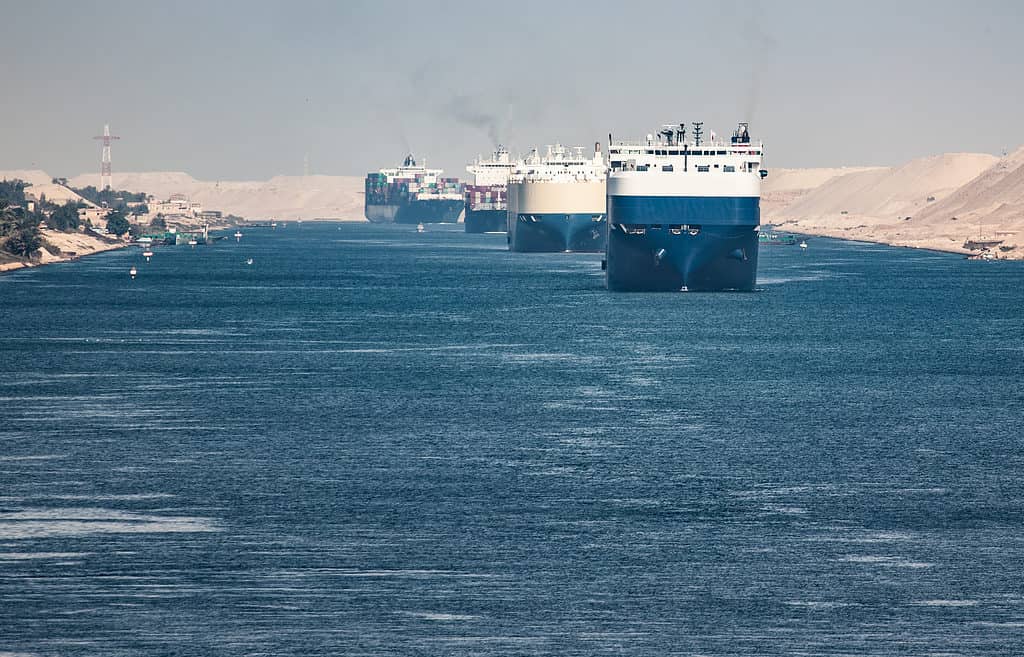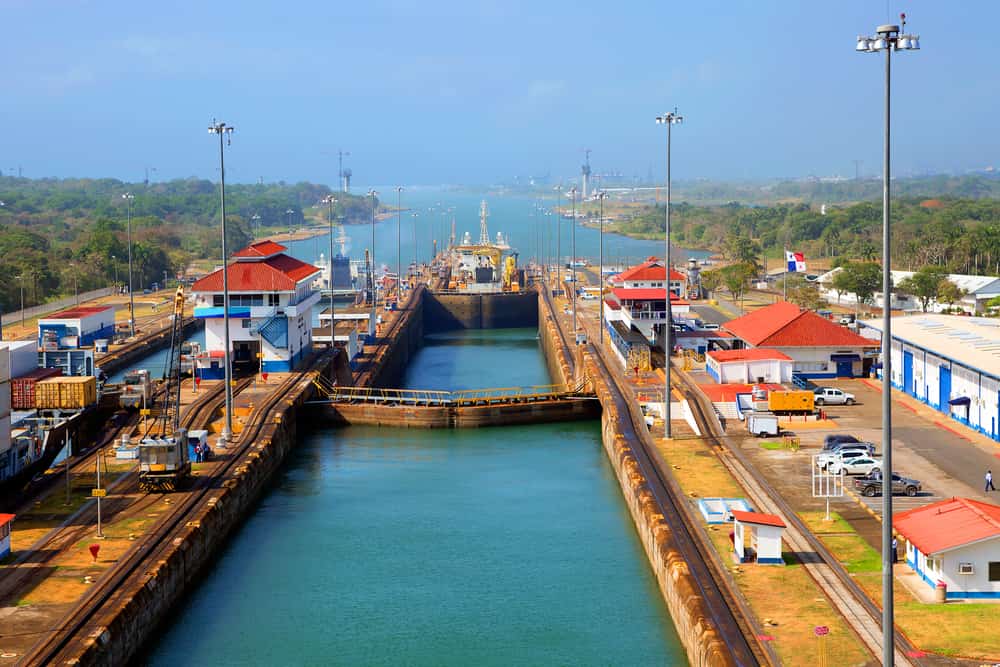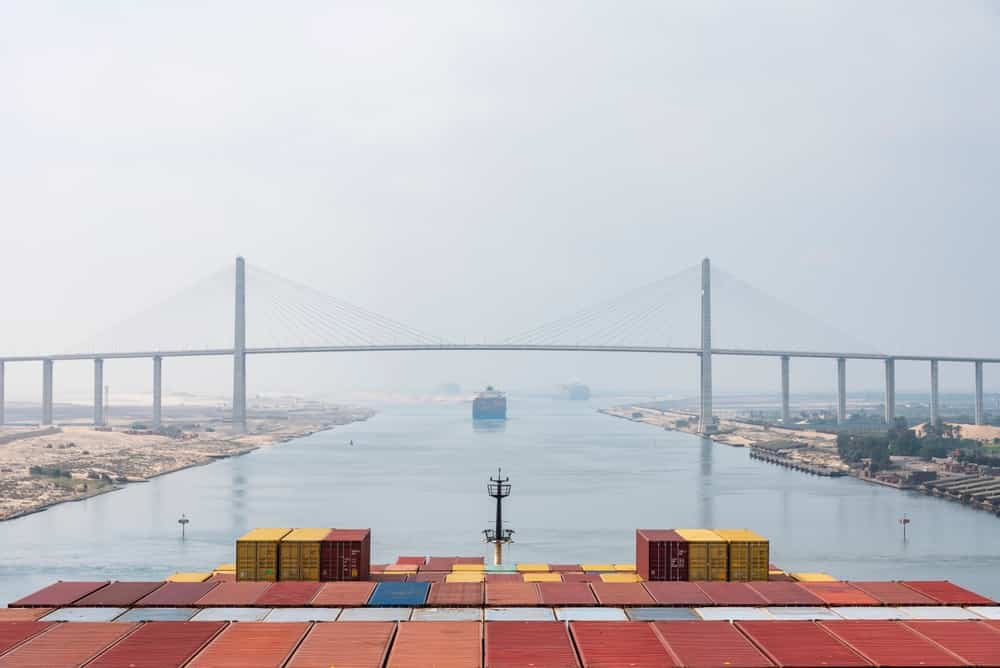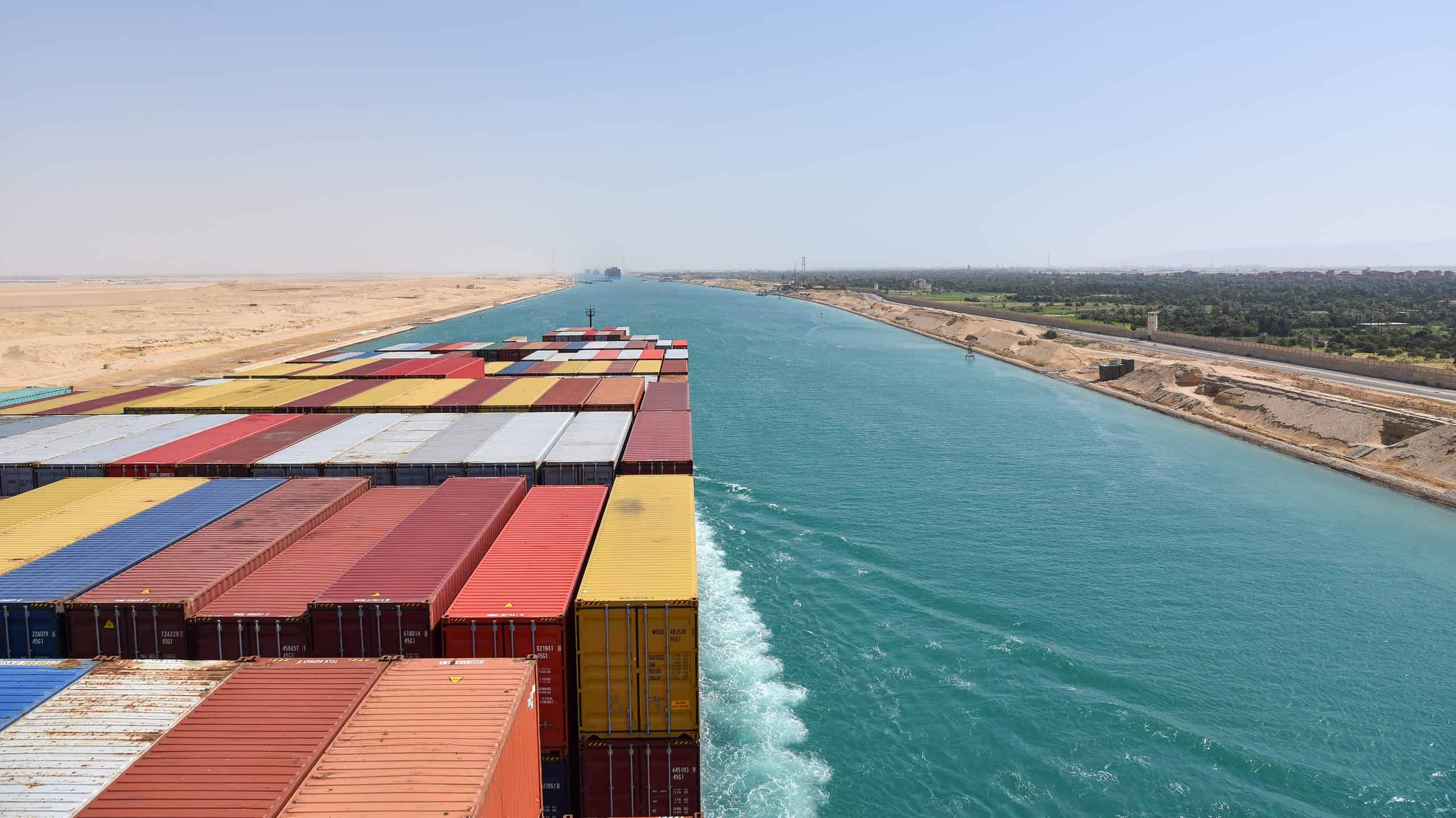Canals are used across the world to connect land, ferry goods, and travel to points of interest. The two most famous canals on the globe — the Suez Canal and the Panama Canal — are engineering marvels within their own rights and connect more than just continents and oceans. Each canal provides a significant impact on the world in its significance, engineering design, economic role, and environmental effects.
Learn more about the Suez Canal and the Panama Canal’s similarities and differences.
History and Significance of Each Canal
The Suez Canal

A handful of cargo ships can drive the Suez Canal at a time.
©Dipix/Shutterstock.com
Officially constructed in 1859, the Suez Canal has been used as a waterway between the Indian Ocean and the Mediterranean Sea (via the Red Sea) as early as 2000 B.C. The Suez Canal sits at a precarious position between Africa and Asia; its connection opens Europe and Africa to trade with the Middle and Far East. In the 1830s, a French engineer-explorer who specialized in Egypt named Linant de Bellefonds, began advocating for countries to build a direct route between the Mediterranean Sea and Indian Ocean. In the early 1850s, then-ruler Khedive Said Pasha of Egypt and the Ottoman Empire commissioned an engineer to begin the project after seeing the opportunities for power and trade with land access the canal would bring.
The creation of the canal soon became rife with turmoil. It is thought to have killed thousands during its 10-year construction, with laborers suffering from cholera, accidents, and other diseases. Against the behest of American, French, and British investors, many of those who worked on the canal were slave laborers. In addition, rebellions against French and British rule in Egypt and limitations on technology slowed progress and doubled the total price of the canal’s construction to $100 million.
In modern times, the Suez Canal has played roles in wars, regional conflicts, and global trade. Egypt made an eight million dollar expansion to the canal in 2014, but nearly seven years later in March 2021, a gigantic container ship became wedged in the widened canal, screeching trade across the globe to a halt for nearly a week.
The Panama Canal

A very narrow passageway lies on Gatun Lake in the Panama Canal complex.
©Joe Benning/Shutterstock.com
The Panama Canal played a crucial role in the colonization of the Americas. As early as the 1500s, explorers like Vasco Nuñez de Balboa saw the tantalizing idea of a “shortcut” from Europe to eastern Asia rather than sailing around South America’s stormy Strait of Magellan. While traders could use the Panama Railroad to transfer goods and people from one ocean to another, the canal would provide the best of both worlds.
While the French were the first to attempt construction of a canal, the project failed miserably thanks to an underestimation of the work. Teams had to battle constant landslides while trying to avoid contracting yellow fever and malaria. Only a few years passed before the French pulled funding and stopped their work.
Nearly 20 years later — and on the heels of Panamanian independence — then-president Teddy Roosevelt negotiated to purchase the French assets around the would-be canal and commissioned the project to begin.
While the first engineer resigned after only a year for similar reasons that sent the French running, an accomplished railroad engineer named John Stevens took up the helm. He hired West Indian laborers, ordered new machinery, and changed the canal’s plan from a sea-level canal to a lock canal to combat terrain issues with the landslides. More setbacks occurred as the construction endured for nearly 11 years, including Stevens’ sudden resignation, a nine-mile excavation, and rumbling worker strikes. Still, the canal project was completed in 1914 and officially opened as World War I bore down on the globe.
Today, the Panama Canal remains one of the seven wonders of the modern world and ferries hundreds of thousands of goods a year.
Technical Details and Design Differences
The most significant difference between the Suez Canal and the Panama Canal is the different lengths and designs. The Suez Canal is longer than the Panama Canal, beating Panama’s 80 kilometers by a large margin at 193 kilometers long. It can also handle larger ships than the Panama Canal can.
The Suez Canal is a sea-level canal, meaning its depth changes with the tides. This type of canal makes sense for deep waters and requires less engineering than a lock system. However, in terrains with jagged mountains nearby and crumbling sediment, a water lock canal (like the Panama Canal) remains one of the only options.
The Panama Canal’s technology was an ingenious and creative solution to the landslides in the Panama isthmus. Because the walls of the “V” design continued to crumble in construction, engineer John Stevens devised a series of six locks — three on each end — that would raise water levels with the ship to ferry it into the artificial Lake Gatun, 26 meters above sea level.
Unlike the Suez Canal, the Panama Canal makes use of tug boats to assist container ships on their journeys through the artificial waterway and avoid incidents.
Comparison of Economic and Geopolitical Impacts

Ships can run aground in narrow canals like the
Ever Givendid in 2021.
©GreenOak/Shutterstock.com
While on opposite ends of the world and handling very different cargo, the economic and geopolitical impacts of the Suez and Panama Canals cannot be overstated.
On the tail end of the COVID-19 pandemic, the massive 400 meter-long container ship Ever Given became lodged diagonally in the Suez Canal. Its unintentional blockade — which halted trade to and from the canal for nearly a week — ground global economies to a halt almost overnight. Ever Given ended up stalling 350 ships from sailing.
Efficiency
The Suez Canal cuts trips down by nearly 8,000 kilometers, saving ships 42% of their trip to the Netherlands to Saudi Arabia. Instead of going around the tip of South Africa, ships can cut across the canal to ferry their products.
Oil remains one of the main exports that travel through the canal; it accounts for 23% of the cargo traveling on the Suez. No real competition or alternative to the Suez exists. The United States and Israel attempted to create other options; the former pursuing an artificial waterway in the 1950s and the latter proposing a transcontinental railroad — but neither came to fruition. The Suez Canal provides invaluable travel routes that foster global trade. In March 2021, the world felt the sting of loss when a blockage in the Suez brought economies to their knees.
“Doorways” to the World

The U.S., China, and Japan make the most use of the Panama Canal.
©Galina Savina/Shutterstock.com
Because Panama intersects the North and South American regions, it’s an unmatched doorway for traders from the Pacific and Atlantic to travel. Sailors and engineers regard its significance with respect; the eight to 10 hours it takes to travel the Panama Canal saves container ships days (or weeks) of travel and remains considerably safer than the alternative routes. Like the Suez Canal, the Panama Canal offers a “shortcut.” This one cuts nearly 15,000 kilometers off of a journey by going above and through South America rather than around the Cape of Good Hope.
China, Japan, and the United States remain the most frequent users of the Panama Canal. A whopping 6% of all the world’s trade travels through the Panama Canal — resulting in billions of dollars for the Panamanian government, thousands of ships traveling through, and hundreds of millions of tons of cargo.
With the significant traffic in the Panama Canal comes regular wear and tear. However, in light of the Suez Canal’s commerce-stopping issues, the government in Panama and other agencies understand how important it is to proactively maintain the canal. In 2022 and 2023, crews began working on the canal to extend its life by, at their estimations, at least another century.
Environmental and Social Issues Surrounding Each Canal

Megaships traverse the Suez daily to the chagrin of some critics.
©Mariusz Bugno/Shutterstock.com
Both the Suez and Panama Canals have environmental considerations to remember when sailors travel them. The Suez is prone to dust and sandstorms that lower visibility while the Panama Canal undergoes torrential rainfalls in certain seasons that can slow or halt travel.
After the Ever Given fiasco of the Suez, experts called into question the use of “megaships” in global trade. Not only do megaships make controversial impacts on the economy, globalization, and political spheres; they affect the fragile marine ecosystems. When the Panama Canal was expanded in 2016, research suggests that it came at the cost of introducing invasive marine organisms and heightening the possibility of decimating the region’s main freshwater source: Lake Gutan.
The Suez Canal and the Panama Canal: Essential Marine Superhighways
While both canals have a rocky history in construction, they’ve played main roles in the industrialization and commercialization of the world. Both canals significantly reduce sailing times for large shipments and create waterways for countries that may not have easy access to the rest of the world for trade. When one of these canals shuts down, it throws the entire world into a panic.
Essential, massive, and continuing to evolve: both the Suez Canal and the Panama Canal remain essential to trade as we know it in the twenty-first century.
Thank you for reading! Have some feedback for us? Contact the AZ Animals editorial team.








